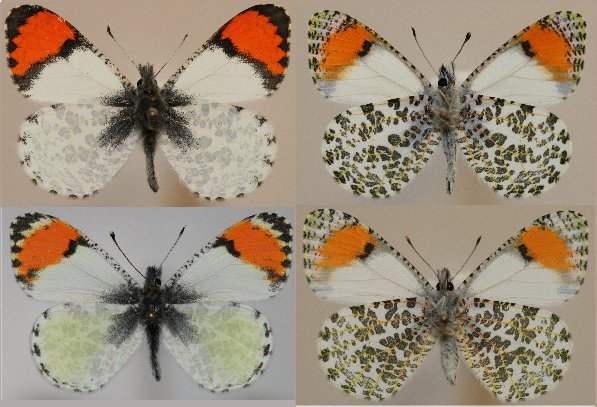Anthocharis sara

Photo Life History: Anthocharis sara
Habitat: Mountain Canyons
Host Plants: Dentaria californica; Arabis sparsiflora; Arabis perennans; Descurainia pinnata; Isatis tinctoria
Suitable Lab Host Plants: Any Arabis species. Isatis tinctoria; Brassica nigra
Caring for Live Female Butterflies: Feed females regularly; Do NOT place live females in glassine envelopes for ANY period of time. They are too fragile.
Methods of Female Oviposition: Portable Cages; Open Screen Cages
How to Find Eggs: Look on Flower Stems; Look on Upper Half of Plant; Isolated Host Plants;
How to Hatch Eggs: Separate eggs individually; Keep egg on original leaf
How to Find Caterpillars in the Field: It is abundantly easier to find eggs and/or to get eggs out of live females. But, to find late instar larvae, (many will have been taken out by predation) look for Caterpillar Strip Patterns.
Caterpillar setups: Open terrariums; Open Bucket
Overwintering Stage: Pupa.
Overwintering Strategies: Your Own Backyard; Refrigerator
Larva to Pupa: Larva Changes Color (goes from dark green to much darker green)
Number of Broods per Year: 1-2 depending upon location.
Avoiding Diapause Techniques: Not effective for univoltine populations; however, if you provide larvae of bivoltine populations Healthy Host Plant, or expose late instar larvae and/or pupae to rain water, that seems to encourage same year emergence of bivoltine populations.
Disease Prevention: Change out host plant and remove frass every three to four days.
Emergence: Emergence Container
Field Notes: Anthocharis sara sempervirens pupae will sometimes emerge same year. Due to field research (in press), subspecies sara, sempervirens, gunderi, and pseudothoosa are applied to species 'sara'.

